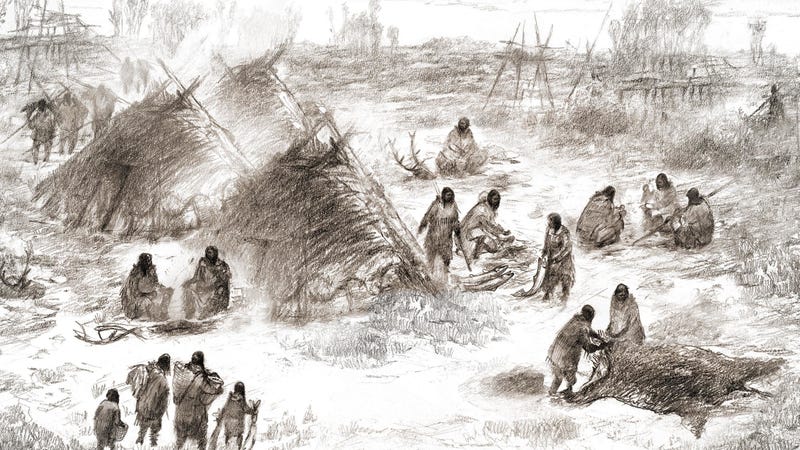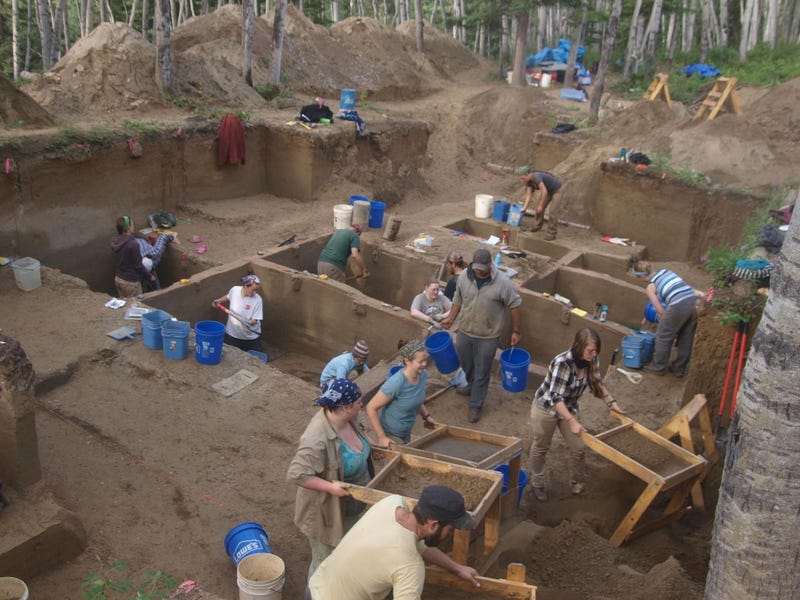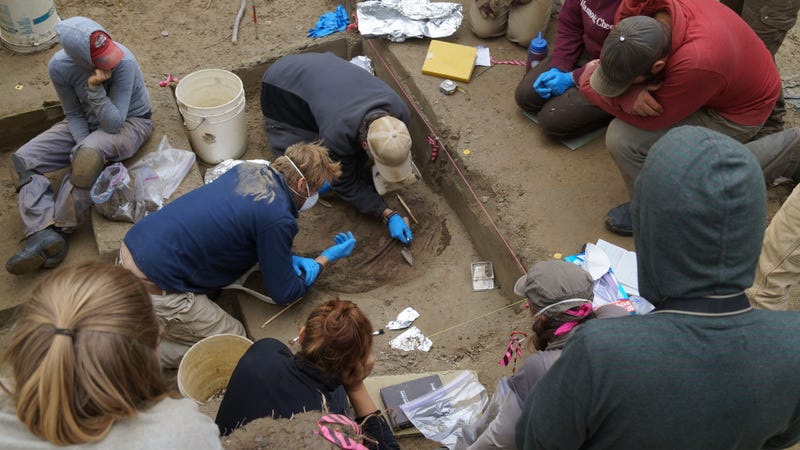Discovery of Unknown Ancient Population Changes Our Understanding of How North America Was Settled

She died 11,500 years ago at the tender age of six weeks in what is now the interior of Alaska. Dubbed “Sunrise Girl-child” by the local indigenous people, the remains of the Ice Age infant—uncovered at an archaeological dig in 2013—contained traces of DNA, allowing scientists to perform a full genomic analysis. Incredibly, this baby girl belonged to a previously unknown population of ancient Native Americans—a discovery that’s changing what we know about the continent’s first people.
 Artist’s depiction of the “Ancient Beringians” and their Upward Sun River base camp.
Artist’s depiction of the “Ancient Beringians” and their Upward Sun River base camp.
Eric S. Carlson in collaboration with Ben Potter
Genetic evidence published today in Nature is the first to show that all Native Americans can trace their ancestry back to a single migration event that happened at the tail-end of the last Ice Age. The evidence—gleaned from the full genomic profile of the six-week-old girl and the partial genomic remains of another infant—suggests the continent’s first settlers arrived in a single migratory wave around 20,900 years ago. But this population then split into two groups—one group that would go on to become the ancestors of all Native North Americans, and another that would venture no further than Alaska—a previously unknown population of ancient North Americans now dubbed the “Ancient Beringians.”
It’s well established that North America’s first settlers migrated from Siberia into Alaska prior to the end of the last Ice Age via an ancient land bridge known as Beringia (actually, the term “bridge” is a bit of a misnomer as Beringia was a sizeable landmass measuring 620 miles (1,000 km) at its widest extent and encompassing an area as large as the Canadian provinces of British Columbia and Alberta combined; those humans living and venturing across this landmass would hardly think of it as a “bridge”). But scientists aren’t sure if there was a single founding group or several, or when the migration actually happened.
 Archaeologists working at the Upward Sun River site in Alaska.
Archaeologists working at the Upward Sun River site in Alaska.
Ben Potter
The remains of two human infants, found at the Upward Sun River (USR) site in the Alaskan interior, are changing what we know of this important period in human history. The researchers who conducted the genetic analysis, which involved teams from the University of Cambridge, the University of Copenhagen, and the University of Alaska Fairbanks, were fully expecting the USR DNA to match the genetic profiles of other northern Native American people—but it matched no other known ancient population, not even the two recognized branches of early indigenous peoples, known as Northern and Southern. It also didn’t match any contemporary human populations.
“We didn’t know this population existed,” said Ben Potter, professor of anthropology at the University of Alaska Fairbanks and a lead author of the new study, in a statement. “These data also provide the first direct evidence of the initial founding Native American population, which sheds new light on how these early populations were migrating and settling throughout North America.”
Genetic analysis showed that these Ancient Beringians were more closely related to early Native Americans than their Asian and Eurasian ancestors. Even though the DNA extracted from the second infant wasn’t able to produce a full genome for analysis, the researchers were able to determine that the two girls belonged to the same population. The genetic analysis, combined with computer-based population modeling, allowed the researchers to conclude that a single founding ancestral indigenous American group split from East Asians around 35,000 years ago. Then, around 20,000 years ago, this group split into two groups: the ancestors of all Native Americans, and the Ancient Beringians.
 Discovery and excavation of the Upward Sun River infants.
Discovery and excavation of the Upward Sun River infants.
Ben Potter)
"The Ancient Beringians diversified from other Native Americans before any ancient or living Native American population sequenced to date. It’s basically a relict population of an ancestral group which was common to all Native Americans, so the sequenced genetic data gave us enormous potential in terms of answering questions relating to the early peopling of the Americas,” said lead author Eske Willerslev, who holds positions at both the University of Cambridge and the University of Copenhagen. “We were able to show that people probably entered Alaska before 20,000 years ago. It’s the first time that we have had direct genomic evidence that all Native Americans can be traced back to one source population, via a single, founding migration event.”
The discovery suggests two possible scenarios for the peopling of the Americas. Either two distinct groups of people crossed over Beringia prior to 15,700 years ago, or one group of people crossed over the land bridge and then split in Beringia into two groups, namely the Ancient Beringians and the Native Americans (where the latter moved south of the ice sheets 15,700 years ago). The study also reaffirms a pre-existing theory known as the “Standstill Model”—the possibility that the descendents of this single-source population were living in Beringia until about 11,500 years ago.
Regardless, it now appears that the Ancient Beringians stayed in the far North for thousands of years, while the ancestors of other Native American peoples spread throughout the rest of North America. The new genetic analysis, along with previous archaeological work, also lends credence to the idea that an offshoot of these migrants, known as the Athabascans, made their way back into the northern regions of North America again, possibly around 6,000 years ago (a process known as back migration), eventually absorbing or replacing the Ancient Beringians. More research will be required to bear this theory out.
“The differences between the genomes of the Upward Sun River infants and the genomes of other ancient Native Americans sets the Alaskan infants apart,” Gary Haynes, an anthropologist at the University of Nevada, told Gizmodo, “But there are also similarities which suggest that all the studied individuals are descendants of a single ancestral founding population. The USR population split after 20,900 years from the population that gave rise to all modern northern and southern Native Americans. The critical importance of this conclusion, if it is correct, is that it provides support for the view that a single founding population from Northeast Asia gave rise to all the native peoples of the Americas. This is a significant finding which establishes that all the pre-Columbian native peoples of the New World are members of one family tree.”
Haynes, who isn’t affiliated with the new study, says it’s important to keep in mind that the paper’s conclusions are based heavily on genetic analysis and that the authors weren’t able to provide empirical support in the form of archaeological evidence with firm dates.
“The suggested dating of population movements and genetic divergences in the paper relies on estimates of genetic rates of change, with tacit support from paleogeographic data (the existence of ice sheets at certain times, for example, blocking human movement), and the implication that archeological claims are correct about human presence [more than 15,000 years ago] in the Americas south of Beringia,” he said.
David Lambert, a professor at Griffith University’s Australian Research Centre for Human Evolution, says the study was “carefully conducted, and employed generally well understood laboratory... methods,” and that the research was of “a very high standard.” Lambert, who wasn’t involved in the new study, says the authors presented strong genomic evidence for a previously unknown but distinct early North American population.
“The conclusions are sound and it is clear that the results represent a significant new chapter in our understanding of the settlement of North America,” Lambert told Gizmodo. “The authors present evidence for a complex history of late Pleistocene genomic evolution that includes evidence for introversion [the spawning of new populations who keep to themselves], back migrations, and evidence of a single founding population that split from East Asians.”
Lambert is particularly stoked about the way ancient DNA is able to produce new and unexpected findings. “This study shows that even a single ancient genome sequenced to a good coverage can potentially make major contributions to our understanding of ancient complex histories,” he said.
Indeed, this study is dependent on a single—albeit really good—sample of DNA. It’s possible the infant could be some kind of a genetic outlier (an unlikely scenario given the similarities observed between the two USR infants). More genetic evidence of these Ancient Beringians, along with more archaeological evidence, will be required to affirm these findings and push this research forward. But it’s an exciting result nonetheless—one that paints more a more complex picture of how North America was settled.
=============================
There may be links in the Original Article that have not been reproduced here.


Amazing is it not to wonder about the lives of such ancient people? Especially when we can learn so much about them from their DNA and surviving physical relics.
( Most amazing is that these people existed well before the planet was ‘created’. /s )
Prehistory in America just keeps going back further and further... It's fascinating.
lol !!!
Given this discovery, imagine now homo sapiens roaming this planet more than 150,000 years before these people were born. I suspect things did not progress much - probably remained stable for thousands of years at a time - but it is fascinating to think that our species was able to survive in a truly hostile, dangerous environment for so long under primitive conditions. How ironic if we bring about our own end through misuse of our advanced technology.
Apparently, no one is really sure why primitive man changed the hunter-gatherer existence they had led for tens of thousands of years. The few remaining Amazonian tribes spend relatively little time hunting and gathering. Mostly they eat, sleep and talk, content with a way of life unchanged since forever.
So what happened in China and Egypt and the Fertile Crescent?
And who built all of the temples and pyramids and the Temple Mount base?
Stones so large, we don't yet have the equipment to move them.
Near perfect joints one cannot get a piece of paper into?
Have we been here before, died out and come back from the edge of extinction to start all over again?
Do you have anything pertinent to the seed?
Truly amazing trying to understand it all.
How 'bout those findings showing human/Native American occupation 130,000 years ago outside the LA/San Diego area next to Highway 54???
Very cool article.
It's a fine illustration of how "published science" operates. I appreciate the author's detailed account of the Cerruti Mammouth, while not drawing an absolute conclusion. Suddenly adding more than 100 000 years to human presence in North America isn't a step to be taken lightly.
As one of the skeptics says, though, “It is these folks who should now be looking at the site and remains — independent researchers, outside the arguments, who could bring skill and expertise to bear on these questions,”
Great find !
From your article............
Any one of these groups could have done it.
.
From my old stomping grounds. Possible evidence of 'humans' in SC 50,000 years ago.
That report came out in '04 - is there an update to it?
Here is the latest info I could find on it.
Excellent find. What I liked about the link are the additional links by Micah and others at the bottom of the page the keep you going and going and going and going
That Cali real estate was far more affordable back then.
Yeah, but then the Europeans showed up and screwed the pooch.
Still only speculation that early humans were there in that time period. This theory needs lots more supporting evidence, including finding bones of these humans.
I posted an article a couple of years ago when the bodies were discovered. Since that time there have been other discoveries that have linked the Clovis people to modern (12,500 years ago) native Americans. Namely ''Montana Boy.''
There are still many question to be answered. In Texas tools have been found that are dated back 16,700 years ago.
In San Diego a dig is working now that suggest's early Americans were here 130,000 years ago.
The find is interesting to say the least, but we've been down this road before, and then some dig or discovery turns up that places doubt in the discovery.
There are sites in South America that date back 14,000 to 16,000 years that have confirmed human habitation...
The more we discover the less we know of how America was inhabited. With the advent of advanced DNA testing, drones and ground penetrating radar I believe that we will keep setting back the habitation of the Americas thousands, perhaps tens of thousands of years earlier then we are aware of today.
Good article we need more like it.
Sinkhole discovery suggests humans were in Florida 14,500 years ago
As Kavika noted above, findings of prehistoric habitation are met with a lot of skepticism - but, more and more sites are being located that are disproving the Beringia land bridge theory. Charles Mann published a book, "1491", that lists findings in South America dating back 30,000 - 50,000 years ago. One cave in Brazil had 40 bodies that have been identified and tagged as being over 40,000 years old - but, the scientific community doesn't want to put their hat in the ring for that one due to complete analysis not being completed.
Fascinating book, I am currently watching the documentary series on the APTN network
As is proper
Free - if you've got a Nook or other reader, you can download the 1491 - and you'll be entranced for days and days on end.
Do you have a download link?
Lol nope, I'm still working on that transitioning to the 21st century thing.
Ummm... Thanks... but at 25 dollars... maybe not...
That is only one link - there are other sites/sources - Goodread, Barnes and Noble,
I ummm... found a ummm... "other" download site... in the meantime...
(The not-very-legal kind... )
)
Thank you.
I'm very much an amateur in these matters, but I see no reason to treat these different finds as mutually exclusive. The land "bridge" certainly existed, but needn't have been the only mode of access to the Americas. Kon Tiki, and all that... (although that was east to west).
"Kon-Tiki" - see my note below.
We live in a time of remarkable discovery as literal digging into the past brings forth more pieces of our histories. Fascinating, yet brings thoughtful reflection on what "I" think I know...living in a constant state of re-evaluation of my "knowledge".
Great seed Bob!
This discovery is amazing. A people that once lived here, unknown and now do not exist any longer. Reminds of the the Cahokia people or the Anasazi people, where did they go and who if anyone is caring their DNA today?
The Hohokam people, who disappeared, have been traced to today's Tohono O'odham Indians of the SW.
I love this stuff.
I think it's pretty well accepted now that the Hopi are direct descendants of the Anasazi. They say that they've always know this, and that the White Man's confusion is due to having stupidly adopted the (late-comer) Navajos' ignorance.
Yup!
Interesting tidbit about the Hohokam people. The scientist's after years of study and DNA testing decided that the Hohokam people were today's Tohono O'odham people. When they went the Tohono O'odham and told them that, the response was, ''we know that, why didn't you just ask us?''....
What a great article! Thanks for this!
I worked Cultural/Natural Resources for DoD for pretty near over 30 years and we always came up with some interesting "stuff" on our military installations. At Cape Canaveral, we found tools and artifacts that definitely fell into the 8-9,000 year time frames - mostly in power line distribution sites belonging to Florida Power and Light. I've got a FLINT spearhead, found on the bottom of Indian River, among other artifacts that were dated over 7,000 ago. Think about it - FLINT spearhead - found in a Florida river - in a geologically developed state that has no flint, specifically on the East Coast.
We found underwater village sites - 1 - 2 miles off the East coast - conducting rocket/capsule recovery, in waters that were only 50' deep. We found the same type of sites off our various installations in Alabama, Miss and Louisiana - also 1 - 2 miles off shore. Thus far, no concerted archeological investigations have been conducted, primarily due to cost and logistics. All of those sites have been preliminarily dated at over 10,000.
Kavika can give you more information regarding the pre-Clovis sites found off LA/Long Beach on the islands just off the coast - that have been dated to be over 10,000 years.
So, during all those years of working, I have always wondered - where did all of those folks migrate from? The timelines are entirely too similar for the Western, Eastern and mid-U.S. populations, ranging from 23,500 (site in cove off Brisbane Bay above Miami) years to this publicized find in Alaska of 11,500 - to the Kennewick Man in Oregon of 9,000 years to the Montana Boy of 12,500 years.
There are finds in Peru, dating back to 26,000, where pottery and shards of CHINESE cultures have been found. How/when did they get there? Sure - by boat/logs tied together? But think - today it takes an ocean-liner 7 days to get from Seattle to Yokohama at about 45 kts per hour. How long did it take the "boat people", if they did indeed come from China, to travel to the South American coasts??? What type of vessels did they have? Was it an expedition or were they fishing folks who got blown off course and drifted for weeks/months before striking land?
My people (Chickasaw) were originally from the Southern side of Mexico. We migrated to the SE in about 450 - 600 AD and the migration took 146 years. So, if it took 146 years to travel 2,621 miles, how long did it take the boat people to travel from Borneo, Australia, China, Japan, Siberia???
I believe we will find that the Northern hemisphere has been populated with humanoids for well over 50,000 years, but the more interesting finding will be - where did THEY come from and how did they get here?
The great ''kelp highway''...transportation via the sea to the islands off California.
Cool links.
Love the coastal migration theory, too bad most evidence would have been flooded by subsequent sea level rise as the climate changed.
The islands off California are a treasure load of information on the early Americans...
You are correct with the rising of the seas over the centuries much may be now underwater. Here is the link to the discovery of a 12/15 year old girl, dated around 12,500 years ago in an underwater cave off the coast of Mexico.
Cool!
The DNA connection is significant.
I believe you're referring to Catalina island if my memory is correct, yep lots of good stuff there and I've read up on the girl previously that was quite the find, I'm hopeful more discoveries/evidence are coming that will further push back the timelines.
No, they would be the Channel Islands off the coast of Ventura Ca.
Damn senility kicking in again lol
I grew up in that area and love the CI.
It's a great area Paula...I love it there.
The thing is that people traveled on foot at very different speeds. Medieval Europeans routinely covered twenty miles per day, and of course the various Eurasian steppe tribes that successively invaded eastern Europe could travel far and fast.
Could they be from multiple origins?
Great fun!!
I'm going to stick with my nookomis (grandmother) theory on this...(Grandmothers are never wrong)
When I asked her as a young child she said, ''we've been here forever''....That's my story and until proven differently I'm sticking with it.
So you have a nookomis, and 1st has a nook...
Nookomis are smarter and can talk more than a nook...True story
And Nookomis' never have to recharge their batteries or need screen protectors to protect them from stray ice cream drips or coffee sprays.
My Nookomis' were known as the ''EverReady Grannies''....The only coffee they ever spilled was when misoomish (grandpa) was reading the morning paper and not paying attention to what what she was talking about. Then, she would nudge his cup so coffee spilled on the paper or his pants...They she would yell, ''aangwaamenodam'' (pay attention)..Usually grandpa was too busy trying to dry out his newspaper or hopping around holding his crotch...LOL
tracking....to read later.
I have been watching documentaries on evolution on Prime Video for the last couple of weeks (and have some in list to re-watch).
I love learning history now that I am out of the classroom and don't have to memorize endless dates. LOL!
In fact, the more I learn, the easier it is to understand the order of the spread of human population around the world.
Because of the tools that are now available to scientists, this is a wonderful time to learn more about the progression of our and other species, including plants!
It has only been in the last few years that scientists have thought of the ''great north'' as a possible resource for migration fossils and such...
This discovery shocked the world and it came from what is now the Yukon..
Here is an interesting site:
Center for the Study of the First Americans
It's a Texas A&M sight, although originally is was the study of Early Man based at the University of Maine.